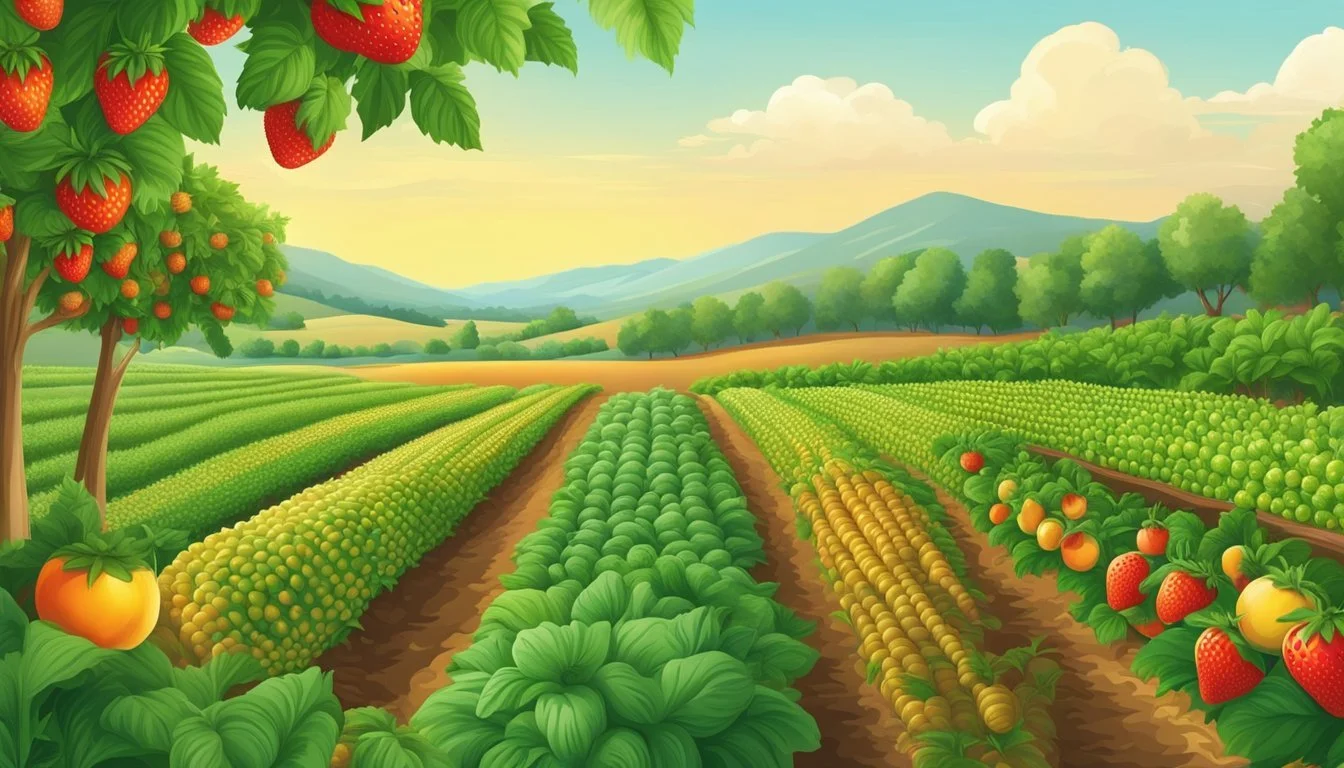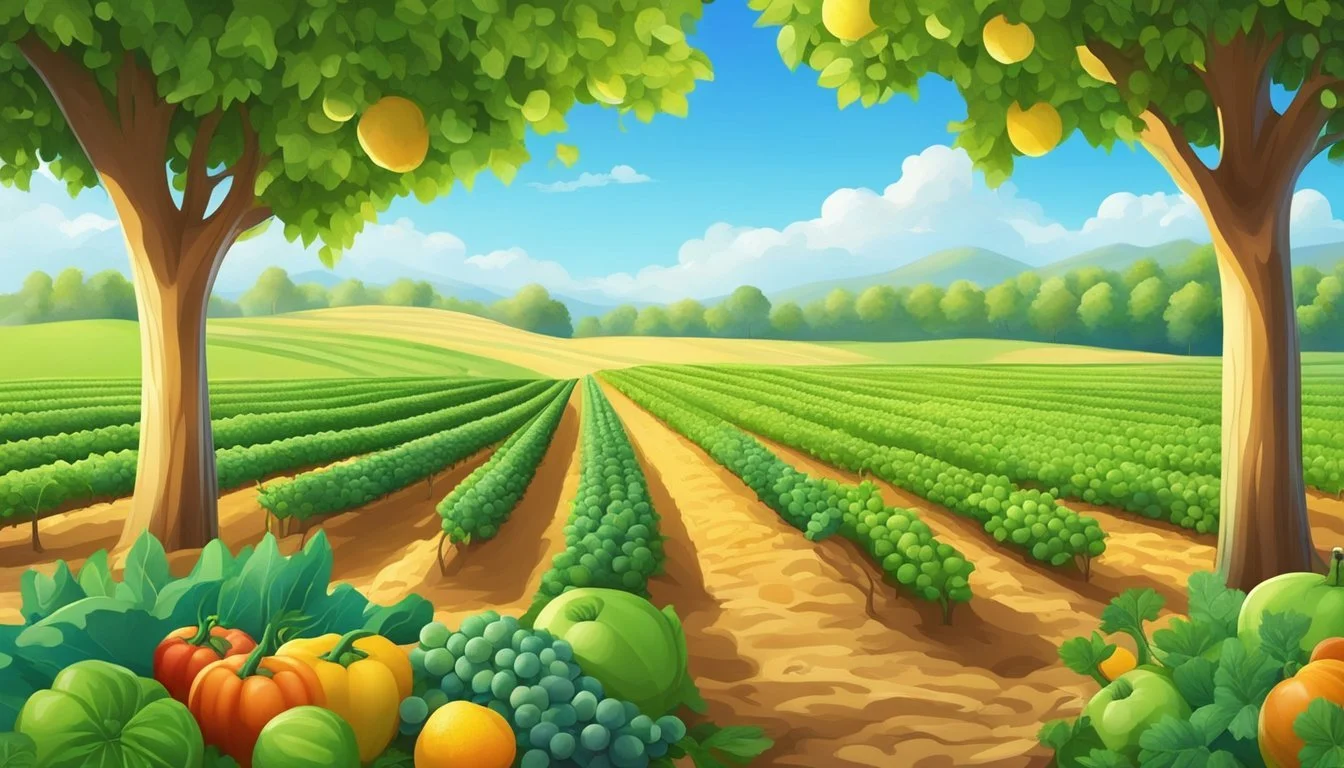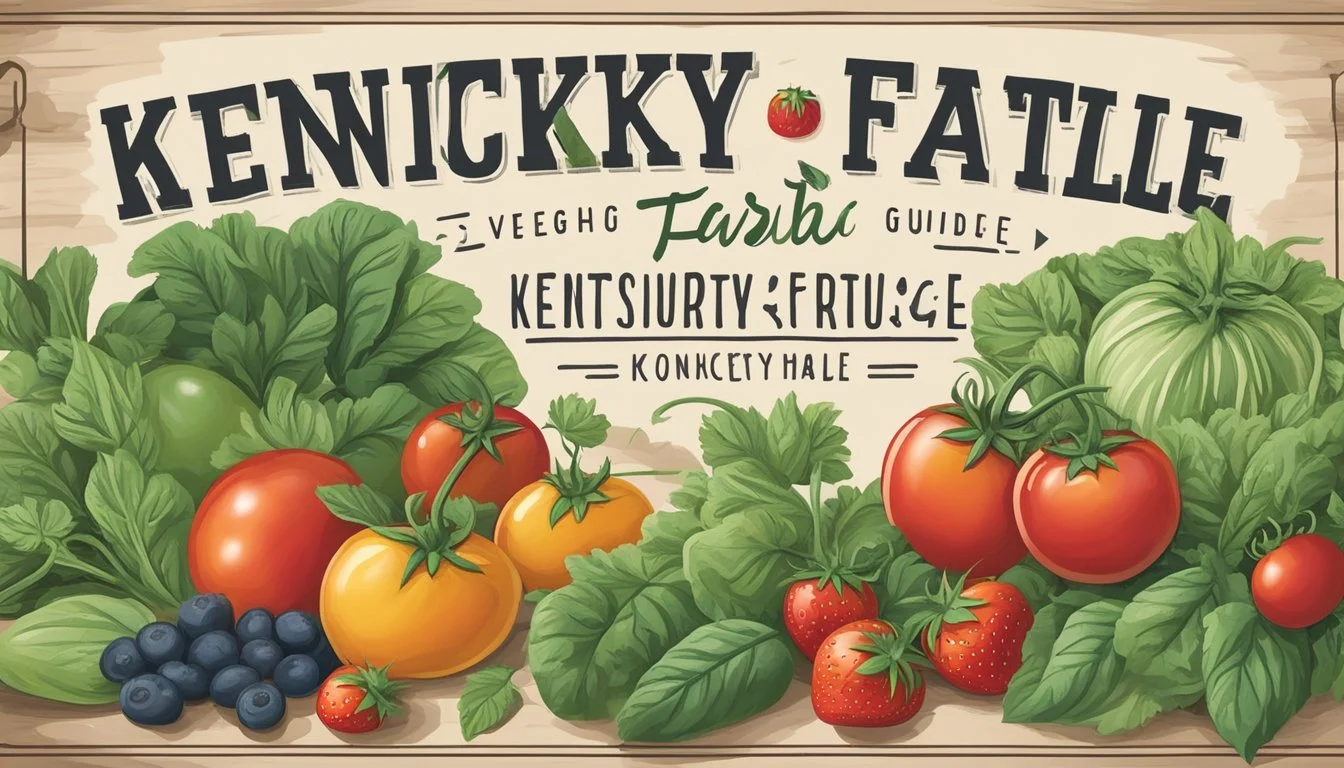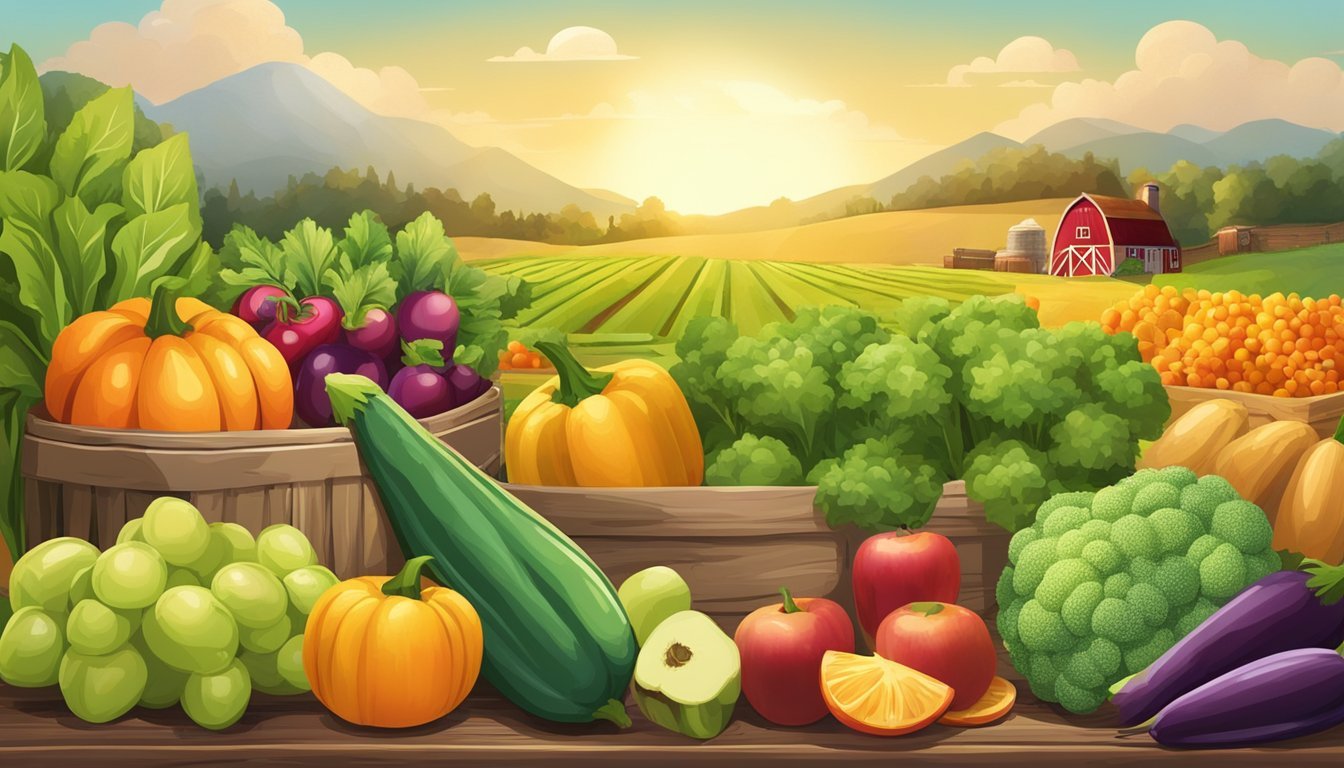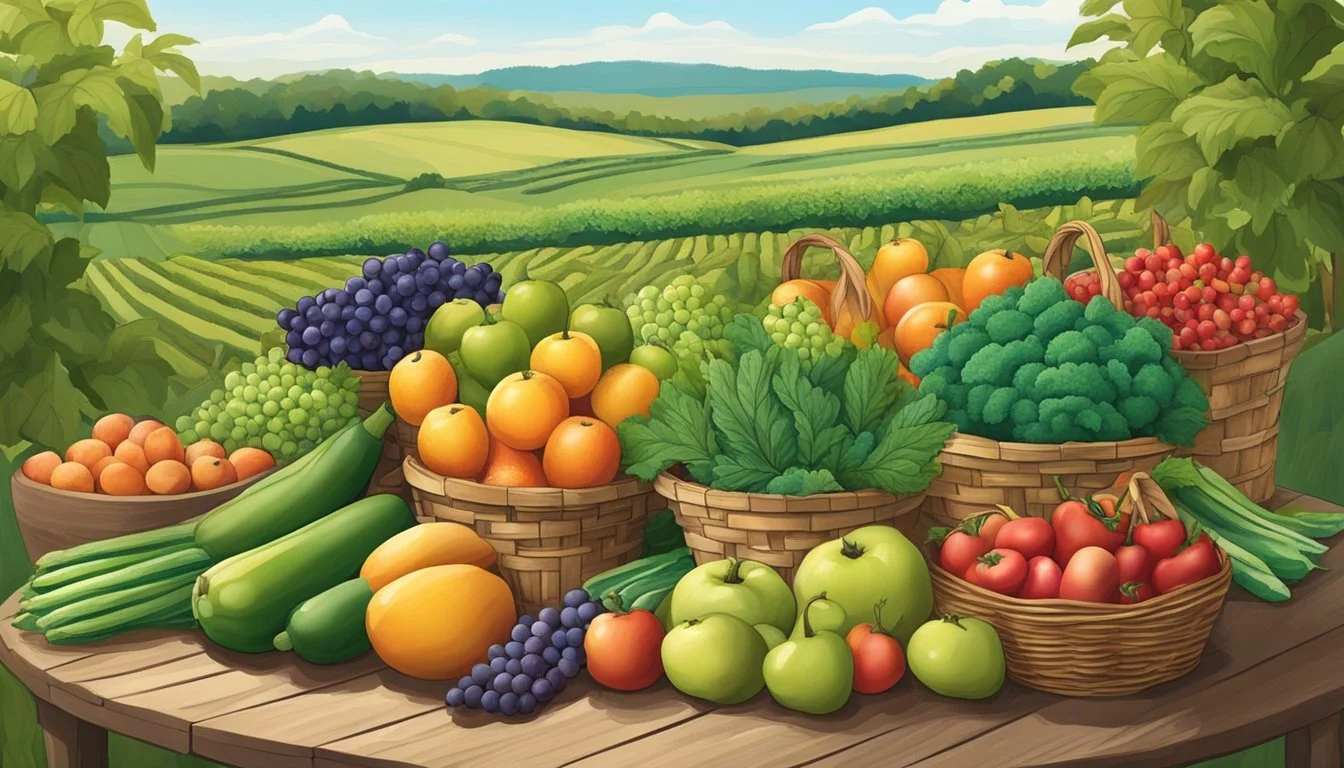Kentucky Seasonal Fruit & Veg Guide
Your Essential Calendar
Kentucky's diverse climate yields a rich tapestry of fruits (What wine goes well with fruits?) and vegetables, making it an ideal region for farm-to-table enthusiasts. As the seasons change, so does the available produce, providing an ever-evolving palette of fresh options for consumers and chefs alike. By aligning their purchases with the natural growing cycles, Kentuckians can enjoy a variety of produce at its peak of flavor, nutrition, and availability. From the tender greens of spring to the hearty squashes of fall, the Kentucky seasonal produce calendar facilitates a deeper connection between the farmers, the food, and the local community.
Farmers markets scattered throughout the Bluegrass State are bustling hubs of activity, offering consumers a chance to engage directly with the source of their food. These markets not only serve as commercial venues but also as social gatherings where the bond between producer and consumer strengthens. Seasonal offerings at these markets reflect the local agriculture and encourage a sustainable food system. This reliance on locally sourced, seasonal produce ensures a fresh and flavorful selection that supports Kentucky's agricultural economy.
A farm-to-table approach in Kentucky showcases the freshest fruits and vegetables while minimizing the distance from farm to plate. This guide aims to help navigate the ebb and flow of Kentucky's seasonal produce, providing insights into when to find the finest local apples (how long do apples last?), the juiciest tomatoes, and the most succulent berries. Whether one is an amateur cook or a professional chef, understanding the seasonality of Kentucky's produce is key to enjoying nutritious, flavorful meals that reflect the best of what the state has to offer.
What’s in Season in Kentucky Right Now?
Understanding Kentucky's Farming Seasons
Kentucky's farming seasons reflect the state's diverse climate and agricultural capabilities. Spanning several hardiness zones, Kentucky farmers must adapt their planting and harvest schedules accordingly to maximize yield and quality.
Spring Harvest
In springtime, Kentucky witnesses the beginning of its planting and growth cycles, with a focus on cold-resistant crops due to the variable temperatures. Hardiness zones in Kentucky typically range from Zone 6a to 7a, influencing which crops can withstand the chill. Early spring allows for the sowing of lettuce, spinach, and kale which are ready for harvest shortly thereafter. Strawberries also start to become abundant by late spring.
Summer Harvest
The summer harvest marks a period of high productivity with warm temperatures allowing a wide array of vegetables and fruits to thrive. Farmers take advantage of the long days to grow popular staples such as tomatoes, corn, green beans, peppers, and cucumbers. Fruit production hits its peak as well, with peaches, berries, and apples like 'Blondee' and 'Gala' becoming ripe for picking.
Fall Harvest
As temperatures cool, Kentucky's fall harvest brings a bountiful array of produce before the frost sets in. This season is ideal for squash, pumpkins, and late crops of broccoli and cauliflower. Apple varieties continue to be a key fruit crop, with late-season apples such as 'Encore' being harvested. Preparation for winter crops also begins, ensuring continued productivity.
Winter Strategies
Winter challenges farmers with colder temperatures and fewer daylight hours. However, they employ strategies such as greenhouses and hoop houses to extend the growing seasons for certain vegetables. Some hardy varieties of greens can survive the mild winters, and farmers use this time to strategize and prepare for the upcoming spring planting. Preserving and storing the harvest from other seasons also ensures year-round availability of local produce.
Guide to Kentucky's Seasonal Vegetables
Kentucky's diverse climate allows for a vast array of vegetables to be grown and enjoyed throughout the changing seasons. This guide provides a concise overview of when to find fresh, locally-grown vegetables in Kentucky.
Leafy Greens & Cruciferous Vegetables
Spring to Early Summer:
Lettuce thrives in the cool, mild weather from March to June.
Chard is best from June onwards.
Kale, with its peak seasonality in spring and fall, is hearty and versatile.
Late Summer to Fall:
Cruciferous vegetables like kale see a second season, becoming sweeter after a frost.
Root Vegetables & Tubers
Fall to Winter:
Hardy carrots are typically harvested from September through November, enduring fall frosts.
Storage & Availability:
Many root crops can be stored and remain available throughout the winter months.
Squashes & Pumpkins
Summer Squash:
Includes varieties like zucchini and yellow squash, prime from June to August.
Winter Squash & Pumpkins:
Reach their peak from September to November.
Variety:
Kentucky produces a broad assortment of squashes, from butternut to acorn, each with its unique season.
Beans & Legumes
Green Beans:
Best harvested in the warm months of June through September.
Varieties:
Include snap beans, pole beans, and bush beans, all thriving in Kentucky's summer climate.
Guide to Kentucky's Seasonal Fruits
Kentucky's climate and fertile soil make it ideal for a variety of fruits throughout the seasons, each offering fresh, local options for farm to table dining.
Berries & Early Summer Fruits
Early summer in Kentucky sees the arrival of a variety of berries. Strawberries make their sweet debut from late spring to early summer. Soon after, blueberries emerge, ready to be picked and enjoyed through the later part of the season.
Strawberries: Late May to June
Blueberries: June to July
Stone Fruits & Midsummer Varieties
Midsummer ushers in a luscious selection of stone fruits. Juicy peaches and cherries are typically ripe for picking in the heart of the summer, providing a succulent centerpiece to the seasonal harvest.
Peaches: July to August
Cherries: June to July
Late Summer and Fall Fruits
As summer wanes, the focus shifts to the robust flavors of late summer and fall fruits. Apples come into prominence, with a wide range boasting a range of flavors from tart to sweet. This time is also perfect for pears, which complement the apple harvest.
Apples: September to November
Pears: August to October
Extended Season & Storage Fruits
Some fruits benefit from storage or have varieties that extend their availability into the colder months. Apples are a prime example, with certain types storing well into winter, ensuring a steady supply beyond their peak harvest season.
Apples: (stored) October to February
Buying and Storing Tips
When it comes to farm-to-table produce in Kentucky, understanding how to select and store fruits and vegetables is key. Freshness is crucial for taste and nutritional value, while proper storage techniques extend the life of your produce and preserve its quality.
Selecting Fresh Produce
One should always look for produce that is firm to touch and free of extensive blemishes or soft spots. Signs of seasonal freshness can often be detected through the produce's vibrant color and pronounced natural aroma. For instance, sweet corn—a summer staple—should have bright green husks and moist, sticky tassels.
Vegetables: Look for an even color and a firm texture.
Fruits: Check for a natural sheen, indicating freshness.
Storage Techniques
Effective storage of fruits and vegetables can significantly lengthen their freshness and flavor:
Temperature & Humidity: Most vegetables thrive in a cold refrigerator environment, ideally between 35-38 degrees Fahrenheit.
Ventilation: Items like onions and garlic benefit from storage in a cool, dark place with low humidity and some air circulation.
Separation: Some produce emit gases that can accelerate spoilage; for instance, onions should be kept separate from potatoes and sweet potatoes.
Water: Some vegetables, like leafy greens, can be stored in a refrigerator wrapped in paper towels to absorb excess moisture.
Fridge Storage Table
Produce Temperature Range Additional Notes Leafy greens 35-38°F Store in vegetable crisper; wrap in paper towels Sweet corn 35-38°F Keep in the husk for maximum freshness Root vegetables 35-38°F Place in a plastic bag with air holes
By following these selection and storage guidelines, one can ensure their Kentucky produce remains as fresh and flavorful as possible from the farm to the table.
Kentucky's Local Farm Landscape
Kentucky's agricultural bounty is supported by a robust network of farms and marketplaces that bring fresh, seasonal produce directly to the consumer. These entities form the backbone of the local farm-to-table movement, contributing to a sustainable food economy.
Community Supported Agriculture (CSA)
Community Supported Agriculture programs are a cornerstone of Kentucky's local food system. They allow consumers to purchase shares of a farm's harvest in advance, providing upfront capital to farmers. Participants receive fresh, seasonal produce throughout the growing cycle, fostering a direct farmer-to-consumer relationship. Listings of CSA programs can typically be found online or at local food co-ops.
Farmers Markets & Food Stands
Farmers markets and roadside food stands are abundant in Kentucky. They serve as critical venues for farmers to sell their produce directly to the public. Consumers come face-to-face with the people who grow their food, gaining insights into the produce's origins and the farming process. These markets often feature a mix of organic and conventionally grown fruits and vegetables, showcasing the diversity and richness of Kentucky's agricultural produce.
Example Markets:
Lexington Farmers Market
Louisville Farmers Market
Orchards and Pick-Your-Own Farms
Orchards and pick-your-own farms in Kentucky offer a hands-on approach to local produce. During specific seasons, orchards open their gates for the public to harvest their own fruits, such as peaches and apples. This not only provides a fresh product for consumers but also a unique family-friendly activity. Many of these farms also incorporate additional attractions, like hayrides and corn mazes, to enhance the visitor experience.
Notable Kentucky Orchards:
Mulberry Orchard
Eckert's Orchard
Growing Your Own
Growing fruits and vegetables in Kentucky can be an enriching and productive endeavor. The right planning and techniques can lead to a bountiful harvest, suitable for any farm-to-table experience.
Planning Your Garden
One's success in cultivating a garden in Kentucky begins with strategic planning. Selecting crops that are suited to the climate is crucial. For example, sweet corn thrives between July and September, which aligns with its peak seasonality. Gardeners should be mindful of first and last frost dates to optimize seed starting times. Kentucky primarily falls within USDA hardiness zones 6 and 7, which provides a diverse range of growing possibilities.
Vertical and Container Gardening
Vertical and container gardening are efficient methods for maximizing limited space or for growing in urban settings. Vertical structures can support climbing vegetables like beans and cucumbers, while containers are ideal for herbs, leafy greens, and dwarf fruit varieties. These approaches not only save space but can also minimize the prevalence of soil-borne diseases and deter some insects.
Disease and Pest Management
A steadfast approach to disease and pest management is imperative for a healthy garden. Regular monitoring for signs of disease and insect damage can prevent minor issues from escalating. For pest control, one can incorporate natural predators such as ladybugs to manage aphid populations. For diseases, practicing crop rotation and using disease-resistant plant varieties are effective strategies.
By following a considered approach to planning, using space effectively with vertical and container gardening, and maintaining vigilance against diseases and pests, one can enjoy a productive and sustainable garden in Kentucky.
Seasonal Recipes and Preparation
Leveraging Kentucky's diverse agricultural produce, individuals can explore a multitude of recipes that bring the freshest flavors to their table. Preparation techniques are pivotal for enhancing the essence of the produce while preserving its nutritional value.
Cooking Techniques
Grilling: For a deeper, smoky flavor, Kentucky's summer vegetables like eggplant and tomatoes are perfected by slow grilling. Slow-grilled pork roast, for instance, is a Kentucky fall favorite, marrying the richness of the meat with the sweetness of in-season produce.
Roasting: Autumn brings root vegetables to the forefront. Recipes such as butternut squash and Brussels sprouts are elevated when roasted, lending a caramelized, hearty flavor ideal for cooler weather.
Braising: Winter calls for heartier fare. One can braise beef with root vegetables like carrots and turnips to create a warm, comforting dish that makes the most of the season's offerings.
Stovetop: Kale and sausage sautéed on the stovetop make for a quick and nutritious meal, easily prepared with fall's hearty greens.
Preserving the Harvest
Canning: Preserving summer's bounty, like berries, allows one to enjoy the fruit's vibrant flavors year-round. Canning in glass jars ensures these flavors are locked in for months.
Cold Storage: Storing root vegetables in a cool, dark place can significantly extend their freshness. Cabbages, beets, and turnips are among those that benefit from proper cold storage, maintaining their flavor and texture.
Refrigeration: For certain produce, refrigerator storage in a crisper drawer or container can prolong shelf life. Apples, greens, and mushrooms should be refrigerated to preserve their crispness and nutritional value.
By following these techniques, Kentuckians can savor the rich tapestry of flavors their state's produce offers, all while taking a farm-to-table approach that respects the natural rhythm of the seasons.
Navigating Health and Nutrition
When one chooses seasonal produce, they are aligning their diet more closely with the natural growing cycles, which can enhance both nutritional value and flavor. Understanding the impact of such choices, as well as the implications of various food labels, is crucial for health-conscious consumers.
Benefits of Seasonal Eating
Consumers can gain a myriad of nutritional benefits from eating fruits and vegetables that are in season. Seasonal produce is often harvested at peak ripeness, which means it typically contains a higher content of vitamins, minerals, and antioxidants than fruits and vegetables that are harvested before they have fully ripened and then transported long distances. For instance, consuming Kentucky's seasonal vegetables like summer squash or tomatoes fresh off the vine can lead to a more nutrient-dense diet.
Moreover, seasonal eating can support local agriculture and sustainability. When individuals opt for fruits and vegetables currently in season in Kentucky, they are more likely to be sourced from local farms, thereby reducing the carbon footprint associated with long-distance food transportation.
Summer: July to September, opt for sweet corn or tomatoes.
Winter: Seek out locally grown root vegetables like beets and carrots.
Understanding Labels and Certifications
Food labels and certifications can be a reliable guideline for consumers who are looking to make healthier and more informed choices. Two common labels that one might come across in Kentucky markets are organic and GAP certified.
Organic: This label indicates that the produce has been grown without the use of synthetic pesticides, genetically modified organisms (GMOs), and artificial fertilizers. Organically grown produce often has higher perceived health benefits, although this is subject to individual nutritional needs and preferences.
GAP (Good Agricultural Practices) Certified: This certification focuses on the safety of the produce in terms of reducing the risks of microbial food contamination. While GAP doesn't directly indicate a nutritional advantage, it does provide assurance of food safety practices in the production process.
Consumers should also note that local farms might not always have the resources to obtain official certifications, despite following organic or sustainable practices, and direct communication with growers can provide further insight into the quality and cultivation methods of the produce.
Resources and Education
Kentucky's Farm to Table movement emphasizes the importance of both community engagement and education. Local organizations and educational institutions offer an array of resources designed to support this movement, including workshops, events, and agricultural extension services, ensuring that both producers and consumers are well-informed.
Workshops and Events
Kentucky hosts numerous workshops and events throughout the year to educate individuals on seasonal produce and local farming practices. These gatherings serve as excellent opportunities for farmers, educators, and consumers alike to learn about:
Seasonal planting and harvesting
Techniques for local marketing
Calendars for these events are typically maintained by local farm organizations and may also be found on statewide agriculture-related websites.
Agricultural Extension Services
The University of Kentucky and other institutions offer Agricultural Extension Services that are vital to the Farm to Table initiative. These services include:
In-person consultations
Educational materials online
Classes and demonstrations about best practices in farming
They also provide resources that help with:
Understanding the intricacies of local food systems
Accessing scientific research to optimize growth and production
Managing pests and disease to ensure hearty crops
Extension services are based on the latest research and tailored to Kentucky's climate and regional produce varieties, ensuring relevancy and practical application.

